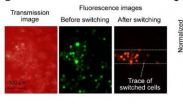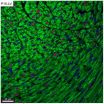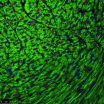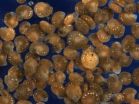(Press-News.org) Patients whose own red blood cells are recycled and given back to them during heart surgery have healthier blood cells better able to carry oxygen where it is most needed compared to those who get transfusions of blood stored in a blood bank, according to results of a small study at Johns Hopkins.
In a report for the June issue of the journal Anesthesia & Analgesia, the researchers say they found that the more units of banked blood a patient received, the more red cell damage they observed. The damage renders the cells less flexible and less able to squeeze through a body's smallest capillaries and deliver oxygen to tissues. Among patients who received five or more units of red blood cells from a hospital blood bank during the study, the damage persisted for at least three days after surgery. In the past, studies have linked transfusions to increased risk of hospital-acquired infections, longer hospital stays and increased risk of death.
"We now have more evidence that fresh blood cells are of a higher quality than what comes from a blood bank," says study leader Steven Frank, M.D., an associate professor of anesthesiology and critical care medicine at the Johns Hopkins University School of Medicine. "If banked blood, which is stored for up to six weeks, is now shown to be of a lower quality, it makes more sense to use recycled blood that has only been outside the body for one or two hours. It's always been the case that patients feel better about getting their own blood, and recycling is also more cost effective."
To recycle the blood, a machine known as a cell saver is used to collect what a patient loses during surgery, rinse away unneeded fat and tissue, and then centrifuge and separate the red cells, which are then returned to the patient should he or she need it. Disposable parts of the cell saver, which can be used to process multiple units of blood, cost around $120, compared to $240 for each unit of banked blood.
Such recycling first became popular during the early years of the HIV/AIDS crisis, so patients could avoid the risk of getting the virus in transfused blood. Today, Frank says, the blood supply is much safer, with the incidence of contracting HIV from a transfusion down from one in 100 in the early 1980s to one in 2 million now — but focus should be on recycling, because fresher blood is better. The practice also reduces the risk of contracting hepatitis B or C infections, or of bad transfusion-related reactions, Frank adds.
For the study, the Johns Hopkins researchers categorized 32 cardiac surgery patients by their transfusion status: those who received only their own recycled red blood cells (12 patients), those who received their own blood plus fewer than five units of banked blood (10) and those who received their own blood plus five or more units of stored blood (10). All had blood samples drawn before, during and for three days after surgery. The samples were examined for blood cell membrane stiffness and flexibility, a measure of how well oxygen is likely to get to where it is needed.
In patients who received only their own recycled blood, their cells behaved normally right away, as if they had never been outside the body. The more blood a patient got from the bank, the less flexible their entire population of red blood cells. Three days after surgery, the red blood cells in the group that got the largest number of transfused units still had not recovered their full function.
"If something is bad for you, a little bit might be OK, but a lot of it is much worse," Frank says. "It turns out that blood is more like milk, which has a relatively short shelf life, than a fine wine, which gets better with age."
Frank cautions that cell saver machines are not appropriate for all operations, and not all hospitals have access to round-the-clock perfusionists to run them. For heart surgeries, however, a perfusionist is already in the operating room to run the heart-lung bypass machine. And, he adds, many operations are considered to be low risk for blood loss, in which case the cell saver is unnecessary. But he advocates wider use of recycled blood.
"In any patient where you expect to give one unit of red blood cells or more, it's cost-effective and beneficial to recycle," he says.
Patients who lose blood may also need platelets and plasma, which they receive regardless of whether they receive their own blood or blood from a bank.
Frank is medical director of the Johns Hopkins Center for Bloodless Medicine and Surgery, which primarily serves Jehovah's Witnesses, who do not accept blood transfusions but will accept recycled cell saver blood.
By using the cell saver as a primary method of blood conservation, their efforts have allowed these patients to do just as well or better than patients who get transfusions of donated blood, he says. Preliminary findings suggest patients who avoid banked blood develop fewer hospital-acquired infections.
INFORMATION:
Other Johns Hopkins researchers who contributed to this study include Osman N. Salaria, M.D.; Viachaslau M. Barodka, M.D.; Charles W. Hogue Jr., M.D.; Dan E. Berkowitz, M.D.; Paul M. Ness, M.D.; and Jack O. Wasey, M.D.
The research was supported by grants from the National Institutes of Health's National Heart, Lung and Blood Institute (R01 HL105296-03 and R01 HL1092259-01) and the New York Community Trust.
Frank has received funding from Haemonetics Corporation to do future research and is also a paid consultant to Haemonetics Corporation. This arrangement has been reviewed and approved by the Johns Hopkins University in accordance with its conflict of interest policies.
Johns Hopkins Medicine (JHM), headquartered in Baltimore, Maryland, is a $6.7 billion integrated global health enterprise and one of the leading health care systems in the United States. JHM unites physicians and scientists of the Johns Hopkins University School of Medicine with the organizations, health professionals and facilities of The Johns Hopkins Hospital and Health System. JHM's vision, "Together, we will deliver the promise of medicine," is supported by its mission to improve the health of the community and the world by setting the standard of excellence in medical education, research and clinical care. Diverse and inclusive, JHM educates medical students, scientists, health care professionals and the public; conducts biomedical research; and provides patient-centered medicine to prevent, diagnose and treat human illness. JHM operates six academic and community hospitals, four suburban health care and surgery centers, and more than 30 primary health care outpatient sites. The Johns Hopkins Hospital, opened in 1889, was ranked number one in the nation for 21 years in a row by U.S. News & World Report.
Johns Hopkins Medicine, 901 South Bond St., Suite 550, Baltimore, MD 21231 United States
Recycling a patient's lost blood during surgery better than using banked blood
2014-05-08
ELSE PRESS RELEASES FROM THIS DATE:
Few women at high-risk for hereditary breast and ovarian cancer receive genetic counseling
2014-05-08
Mutations in the BRCA1 and BRCA2 genes account for nearly 25 percent of hereditary breast cancers and most hereditary ovarian cancers, yet a study by cancer prevention and control researchers at Virginia Commonwealth University Massey Cancer Center suggests an alarmingly small amount of women who qualify for BRCA genetic counseling actually receive the services. Additionally, they found that a significant proportion of women with a family history of breast and ovarian cancer underestimate their own risk.
The study, published in the April edition of the Journal of Community ...
Anti-aging factor offers brain boost too
2014-05-08
A variant of the gene KLOTHO is known for its anti-aging effects in people fortunate enough to carry one copy. Now researchers find that it also has benefits when it comes to brain function. The variant appears to lend beneficial cognitive effects by increasing overall levels of klotho in the bloodstream and brain.
What's more, the improvements in learning and memory associated with klotho elevation aren't strictly tied to aging. They do occur in aging mice, but also in young animals, according to a report published in the Cell Press journal Cell Reports on May 8th. ...
What vigilant squid can teach us about the purpose of pain
2014-05-08
Most of us have probably felt that lasting sense of anxiety or even pain after enduring some kind of accident or injury. Now, researchers have the first evidence in any animal that there may be a very good reason for that kind of heightened sensitivity—or at least there is in the battle of squid versus fish. Squid that behave with extra vigilance after experiencing even a minor injury are more likely to live to see another day, according to a report appearing in the Cell Press journal Current Biology on May 8.
The findings suggest that behaviors that appear counterproductive ...
Antibiotic resistance genes are essentially everywhere
2014-05-08
The largest metagenomic search for antibiotic resistance genes in the DNA sequences of microbial communities from around the globe has found that bacteria carrying those vexing genes turn up everywhere in nature that scientists look for them. The findings reported in the Cell Press journal Current Biology on May 8 add to evidence showing just how common and abundant those resistance genes really are in natural environments.
This big-picture, ecological view on a growing healthcare concern emphasizes the important relationship between antibiotic resistance in the clinic ...
New technology using florescent proteins tracks cancer cells circulating in the blood
2014-05-08
After cancer spreads, finding and destroying malignant cells that circulate in the body is usually critical to patient survival. Now, researchers reporting in the Cell Press journal Chemistry & Biology have developed a new method that allows investigators to label and track single tumor cells circulating in the blood. This advance could help investigators develop a better understanding of cancer spread and how to stop it.
Cancer spread, or metastasis, leads to up to 90% of cancer deaths. Investigators currently do not have the clinical capability to intervene and stop ...
Spurt of heart muscle cell division seen in mice well after birth
2014-05-08
The entire heart muscle in young children may hold untapped potential for regeneration, new research suggests.
For decades, scientists believed that after a child's first few days of life, cardiac muscle cells did not divide. Instead, the assumption was that the heart could only grow by having the muscle cells become larger.
Cracks were already appearing in that theory. But new findings in mice, scheduled for publication in Cell, provide a dramatic counterexample -- with implications for the treatment of congenital heart disorders in humans.
Researchers at Emory University ...
Discovery that heart cells replicate during adolescence opens new avenue for heart repair
2014-05-08
It is widely accepted that heart muscle cells in mammals stop replicating shortly after birth, limiting the ability of the heart to repair itself after injury. A study published by Cell Press May 8th in the journal Cell now shows that heart muscle cells in mice undergo a brief proliferative burst prior to adolescence, increasing in number by about 40% to allow the heart to meet the increased circulatory needs of the body during a period of rapid growth. The findings suggest that thyroid hormone therapy could stimulate this process and enhance the heart's ability to regenerate ...
Polar bear genome reveals rapid adaptation to fatty diet
2014-05-08
Polar bears adapted to life in cold Arctic climates in part by relying on a high-fat diet mainly consisting of seals and their blubber. In a study published by Cell Press May 8th in the journal Cell, researchers discovered that mutations in genes involved in cardiovascular function allowed polar bears to rapidly evolve the ability to consume a fatty diet without developing high rates of heart disease. Moreover, the study revealed that polar bears diverged from brown bears less than 500,000 years ago—much more recently than estimates based on previous genomic data.
"In ...
Using genetics to measure the environmental impact of salmon farming
2014-05-08
Determining species diversity makes it possible to estimate the impact of human activity on marine ecosystems accurately. The environmental effects of salmon farming have been assessed, until now, by visually identifying the animals living in the marine sediment samples collected at specific distances from farming sites. A team led by Jan Pawlowski, professor at the Faculty of Science of the University of Geneva (UNIGE), Switzerland, analysed this type of sediment using a technique known as "DNA barcoding" that targets certain micro-organisms. Their research, which has ...
Humans may benefit from new insights into polar bear's adaptation to high-fat diet
2014-05-08
A comparison of the genomes of polar bears and brown bears reveals that the polar bear is a much younger species than previously believed, having diverged from brown bears less than 500,000 years ago.
The analysis also uncovered several genes that may be involved in the polar bears' extreme adaptations to life in the high Arctic. The species lives much of its life on sea ice, where it subsists on a blubber-rich diet of primarily marine mammals.
The genes pinpointed by the study are related to fatty acid metabolism and cardiovascular function, and may explain the bear's ...




